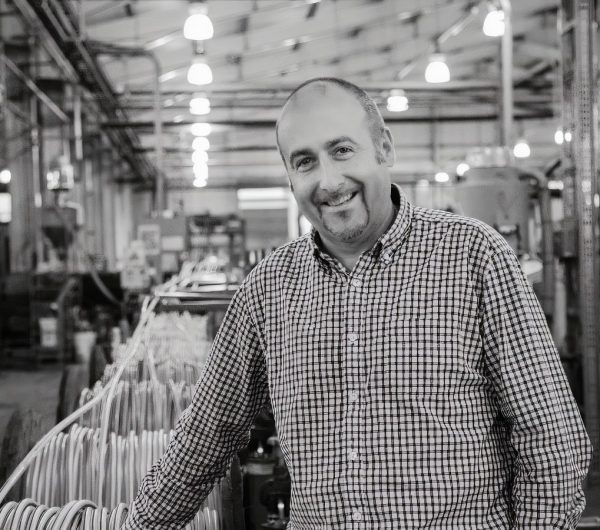Emtelle UK Calls for One Dig Strategy to Help Gigabit Broadband

The Solutions Director (Colin Kirkpatrick) for Emtelle UK, which is a global manufacturer of blown fibre and ducted network solutions for the industry, has told ISPreview.co.uk in a new interview that ISPs should focus on a “One Dig” strategy to boost the roll-out of “gigabit broadband” by building and sharing spare duct space.
Emtelle is a company that might not be all that familiar to broadband consumers, but it’s a different story for any ISPs building “full fibre” infrastructure today. The company began life in 1981 by manufacturing PVC Telecoms Ducting and one of their first major contract wins was the General Post Office (GPO), which is better known today as BT.
In 1993 the company started manufacturing microducts (i.e. special tubes that can carry telecoms cables, such as fibre optic or copper) and blown tube bundles. Suffice to say that they’ve grown rapidly since then and are now a key supplier to numerous fibre (FTTx) network builders across the world (supplying over 100 countries).
Advertisement
As a result of all this Emtelle has a unique insight into a different side of the industry. In particular the company’s Solutions Director, Colin Kirkpatrick, has confirmed to ISPreview.co.uk that “there is a clear shortage of fibre engineers” in the market, which is something that many network builders have also highlighted over the past couple of years.
The company is also an advocate for the “One Dig” strategy, which is a proposal that calls for anybody who builds fibre to add spare duct capacity so that telecoms, and possibly even power cables, can also use the space if required “without excessive digging … This may enable the UK at some point in the future to leapfrog many countries in the race for getting ultimate connectivity.” But getting rivals to agree on such things is like herding cats.
Check out what else Colin had to say in our brief interview piece below.
The Interview
Q1. 2020 is currently shaping up to be a very different year from previous ones, not least due to the impact of the COVID-19 (Coronavirus) on complex supply chains and network deployments. Can you tell us a bit about what sort of impact the pandemic has had on your company (or is expected to have in the near future), if any, and how you’ve had to adapt?
Advertisement
ANSWER:
The COVID-19 pandemic is unprecedented, and like many businesses, we have had to adapt quickly to react to the developments set out by regional governments globally. Thankfully, responding quickly and thinking innovatively has always been a trait of Emtelle’s.
Of course, the health and safety of our employees has always been paramount throughout the crisis, with reduced staff present in our regional factories and offices to ensure social distancing measures are abided to across all of our sites and where possible our team have worked from home.
This pandemic has proven the dependency on superfast connections, and our customers have been deemed as essential workers within the power and telecoms industries. With our unique capabilities of having four cross-functional manufacturing sites across Europe, we have still been able to serve the industry to the highest-level possible and deliver supply as close to normal as we can.
Q2. Emtelle makes a lot of different infrastructure for fibre optic broadband networks. Can you tell us, what in your view have been the biggest innovations in the products that you supply over the past few years?
ANSWER:
Within the industry, the need for quicker and more reliable fibre connections is growing, but we are increasingly challenged by the skills shortage within the FTTX sector. Emtelle has continued to work closely with our customers to develop solutions to overcome such problems.
Our innovative pre-installed and pre-connectorised fibre solutions have done exactly this. We have Multifu, which has proven increasingly popular across Europe where we pre-install the fibre into the tube bundle meaning there is no requirement to blow the fibre in by the contractor, saving time and money. We also have our pre-connectorised QWKConnect and QWKlink product ranges which make the home connection simple and easy to connect – Plug and Play is something needed when there are so many homes still requiring a fibre connection.
These solutions ultimately enable our customers to connect more homes and businesses quicker than ever before. These innovative solutions are being deployed in Fibre-To-The-Home (FTTH) applications globally by key telecoms operators, including Virgin Media, Gigaclear, and CityFibre.
We have even expanded our facilities and now have our own in-house Fibre Termination Facility to help us better serve the market with more pre-connectorised solutions.
Q3. Speaking of innovations, are there any big product developments or changes planned for the future that could potentially have a big impact on the market for and / or deployment pace of fibre optic broadband services (e.g. new types of cable, machinery etc.)?
ANSWER:
Already 2020 has proven an exciting year for Emtelle, having invested in various aspects across the business. Some include our recently purchased 16,000m² of land adjacent to our Emtelle GmbH manufacturing facility, and we have purchased new extrusion lines so we can increase our capabilities at better serving the FTTX market.
As a market leader, Emtelle is always working on new developments and is currently in the process of testing new solutions for customers to utilise in both urban and rural environments.
We will continue to invest in the business to ensure we are best placed to serve our customers globally. We have some exciting plans coming up very soon, which include expansions of our solutions ranges, stock-holding offerings, and manufacturing capabilities not just in the UK and Europe, but also further afield.
We have just announced our new venture, Emcab, which is a brand-new optical cable manufacturer in Germany operating around the world. Ultimately, this increases our cable offering but allows us to serve the UK & European market from a central location with the best quality cables using the best quality fibres.
We are always be developing new innovative solutions that make deployments more efficient, stronger and reliable than ever before, so watch this space!
Q4. The roll-out pace of FTTP technology in the United Kingdom has been ramping up quite significantly over the past 2-3 years. Has Emtelle benefited from this and if so, what have you had to do in order to adapt?
ANSWER:
The UK market is slightly different compared to Mainland Europe as 100mm PVC ducts and overhead cables are used widely. Emtelle has been a main supplier in the UK market for nearly 40 years, so we know what installation methods can be used and the most suitable products for installation. We have grown our buried and overhead product ranges and we are looking to pre-fibre some of these products to enable a faster and less complicated homes passed and homes connected scenario for our clients.
These solutions have proven popular with our clients and the business has grown in the last two-to-three years because of this. Of course, there are also new ideas being trialled by Emtelle and our customers in the UK to reduce the Total Cost of Ownership (TCO) for Fibre-To-The-Premises (FTTP); we are always developing, and the process never stops. Fibre needs to be easy to access anywhere along a route for FTTP, 5G and for future Internet of Things (IoT) and I think that’s where we have had to adapt technically, by taking into account what may be needed in the future as well as right now.
We have implemented a new Fibre Termination Facility where fibre is cut and polished on-site at our Emtelle Centre of Excellence in Hawick, again meaning we can manufacture and supply solutions to our customers more efficiently from two UK locations.
Q5. No doubt many of Emtelle’s primary UK customers will be larger operators like BT (Openreach) and Virgin Media, but we know that you also work with alternative network providers, from fair sized players like Cityfibre to smaller ones like B4RN. Can you tell us, using your unique perspective on the market, what sort of impact do you think altnets are now having vs 5 years ago?
Advertisement
ANSWER:
We are seeing a rise in the number of alternative networks that are running fibre across the UK regions, and it looks set that this will continue in the future. The network is not dominated by one single provider and there is increased growth in fibre networks, as well as more competition in the FTTH marketplace, which increases the number of FTTP deployments.
End-users are dependant more than ever on an ultra-fast, reliable fibre broadband connection, and to keep up with this demand, providers need to connect homes and businesses efficiently. We understand that altnets require partners such as Emtelle, which can provide a high-quality solution, not just in terms of products but also service and support, from concept to installation and beyond.
Q6. What in your view are currently the biggest obstacles to “gigabit-capable” broadband being able to reach almost every home in the UK by the end of 2025 (Government’s £5bn plan)?
ANSWER:
There are understandably multiple challenges to be overcome in order to meet broadband targets, but if the correct solutions are deployed, more success can be anticipated.
There is a clear shortage of fibre engineers and civils team compared to the intended deployment rate in what can be described as a fibre-focussed future. If Gigabit-capability is going to reach every home by 2025, the installation side of the industry needs to grow rapidly with skilled civils crews and fibre technicians available to take on this massive task.
We will do our best to help as much as we can and we have capacity to supply a lot of FTTP products to the industry. We will always be on-hand to do our bit as a manufacturer, supplier and solutions provider to make FTTP as easy as possible.
Q7. What steps is Emtelle taking to make sure it continues to expand and remain ahead of its global competitors?
ANSWER:
We have announced the beginning of our focused expansion at Emtelle GmbH manufacturing facility in Erfurt with the purchase of new extrusion lines and additional land. We are already Europe’s largest microduct manufacturer in terms of capacity with our existing 58 manufacturing lines, but we are dedicated to continuous development and investment in our capabilities, so we can better serve our global customers with high-quality fibre and duct solutions.
We are committed to our full solution approach by being able to offer our customers the entire package, from design and development concept, quality and efficient product manufacture, training and support, to exemplary stocking and logistics service.
Emtelle is in the unique position that we manufacture everything in Europe, meaning customers can count on quality and rely on optimum lead times compared to those competitors who may require the outsourcing of certain manufacturing methods.
Q8. Finally, if you could change one thing about the UK market today (other than COVID-19 related issues), then what would it be?
ANSWER:
One Dig – The future of communications is developing all the time, FTTP is being deployed around the world and some countries are ahead of others in their homes passed and homes connected roll-outs. The most expensive part of any fibre deployments is the digging process. I would like to see FTTP projects and all fibre projects provisioning some space for the future.
With 5G around the corner and IoT, Smart Cities and EV networks being evaluated and deployed, now would be a good time to add in spare duct capacity so that fibre and power cables can be to installed to any point along any road or street in the future without excessive digging. This may enable the UK at some point in the future to leapfrog many countries in the race for getting ultimate connectivity.
A big thanks to Colin and Emtelle for agreeing to take part in our interview.
Mark is a professional technology writer, IT consultant and computer engineer from Dorset (England), he also founded ISPreview in 1999 and enjoys analysing the latest telecoms and broadband developments. Find me on X (Twitter), Mastodon, Facebook, BlueSky, Threads.net and Linkedin.
« Clearing Up Confusion Over the BT FTTP Digital Voice Transition






















































Unfortunately theres no tangible profit in installing spare capacity at an increased cost to deploy. It’s obviously a wise thing to do looking to the long term needs, but the current Industry driver is to reduce costs now, how much that hurts later is a problem for another day.
Openrach are already dealing with the budget/target driven decisions made when deploying FTTC, I’m sure theres alot of wishing things had been done different in the industry.
Maybe profit now shouldn’t always be the primary objective.
Too true.
But with subtended headends a lot of the FTTC fibre is getting a second life.
Trenching deeper for power would add a lot to the cost.
With capital budgets very stretched for a National roll out I see zero chance of this happening unless there is an EV charging partner who shares cost at build. That would be worth exploring.
As for EV charging it will have to happen at some point as there are not enough lap posts and we can’t all be running cables across the pavements.
“ Maybe profit now shouldn’t always be the primary objective.”
OK so are you goi g to tell the markets that the objective is not about getting returns or shall I?
You would find the presently heathy supply of capital dries up very fast if you did that!!
I’m not saying there shouldn’t be profit, rather that short term profit above all other considerations may not achieve the best long term return.
No-one is investing in this expecting short term returns. It is far too capital intensive for that.
“ No-one is investing in this expecting short term returns. It is far too capital intensive for that.”
Yup but there needs to be a pathway to recover the excess cost of adding additional duct capacity.
If that pathway involves LA or Co that want to roll our kerbside carving then all good.
> But with subtended headends a lot of the FTTC fibre is getting a second life
Do you have any figures to back up this claim? Have you seen subtended headends deployed in any but the most rural locations?
Subtended headends only make sense when the fibre runs are so long that they can’t be lit directly from the GEA headend exchange. Otherwise they make the FTTP network dependent on cabinet power, which adds to the long-term cost and reduces reliability.
If OR have duct/pole access/rental agreements maybe it should be a condition on all installers to install extra capacity duct space and allow access……
Alternatively insist all physical fibre should be a common standard install. The battle ground should be at the exchange/splitter and the ISP services provided.
Emtelle is a brilliant supplier, they presented us with a golden duct to mark 5 million metres we’ve dug in. Half way round the moon. But we’re over the moon with them. Agree on duct share, we asked the electric, gas and water if we could share their digs for our fibre across a small country B road. The answer from all three was no, and so there are four cuts across the road, each involving traffic management and big costs over a 6 month period.
Why not have one company owning the Fibre Network? That’s is far more efficient and would speed up the roll out and reduce cost substantially. The Fibre company would not be able to provide a service to end uses. This cuts out a conflict of interest
With a single company you can properly plan a national network rather than the ad hoc roll out by multiple companies at present
What we have at present is not dissimilar to the initial cable TVC roll out and that did not go well. Each operate tended to have its own bespoke system
Eventually all this cable TV companies merged into one but not without a lot of problems and costs and delays